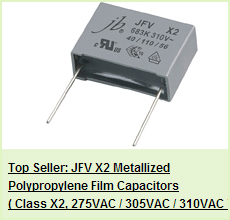jb Basic Technical Information For Car Audio Electronics DIY
jb keywords :electrolytic capacitors, axial lead film capacitors, audio capacitores, Snap-in electrolytic capacitors, Surface Mount Aluminum Electrolytic Capacitors
First ,wish you a prosperous new year .Then let me introduce some basic technical information for car audio electronics DIY to you.
A capacitor is an electronic device which consists of two plates (electrically conductive material) separated by an insulator. The capacitor's value (its 'capacitance') is largely determined by the total surface area of the plates and the distance between the plates (determined by the insulator's thickness). A capacitor's value is commonly referred to in microfarads, one millionth of a farad. It is expressed in micro farads because the farad is such a large amount of capacitance that it would be impractical to use in most situations. Film Capacitors:
Many low value capacitors (less than 1 microfarad) will have a plastic type of insulator (polyethylene, polypropylene...) between the plates. Sometimes the plates are actually a metallized layer bonded onto one side of the plastic material. Multiple layers of the metalized plastic material make up the capacitor. Adding layers or increasing the size of the layers (without increasing the thickness of the layers) will increase capacitance. The following diagram is an incredibly generic film capacitor. You can see the dark blue insulating film between the cyan and violet plates. The plates are soldered to one of the terminals on one end of the plates. Half of the plates are soldered to terminal A and the other half of the plates are soldered to terminal B .Please refer to below drawing which tell you how a capacitor works.

Pls. focus on jb most strong series: JFB--MKT (Metallized Polyester ) Film Capacitors &JFV--X2 MKP (Metallized Polypropylene) Film Capacitors. Aslo jb capaciors company can offer all kinds of capacitor.We are just your best choice !
Any question,please feel free to contact us.






0 Comment so far
Leave a reply